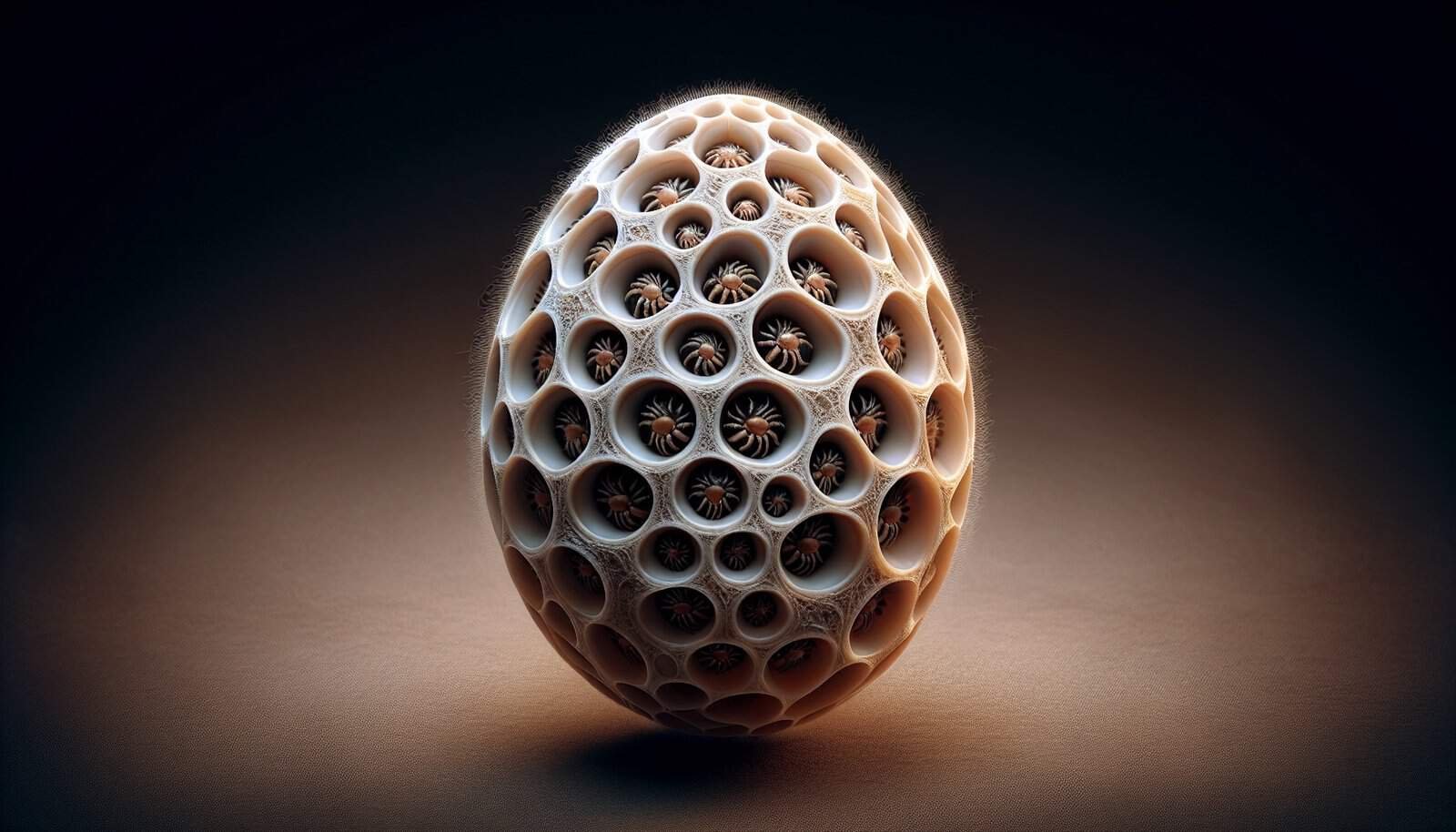Imagine the mystery and intrigue that surrounds the tiny, delicate world inside a tarantula egg sac. Have you ever wondered just how many precious eggs are tucked away inside? Get ready to be amazed as we uncover the fascinating answer. Journey with us as we explore the secrets of the arachnid kingdom, and prepare to be astonished by the sheer number of eggs found within a typical tarantula egg sac. Get ready to have your curiosity satisfied and your mind blown by the incredible number of life waiting to hatch and conquer the world!
Tarantula Egg Sac Basics
Tarantulas, those fascinating eight-legged creatures, have a unique way of reproducing through the formation of egg sacs. These sacs, often hidden and camouflaged, hold the future generations of these arachnids. Understanding the basics of tarantula egg sacs can shed light on the fascinating world of these creatures.
Composition of an egg sac
Tarantula egg sacs are made up of a tough, fibrous material produced by the female tarantula. The silk-like substance is secreted through spinnerets located at the end of her abdomen. This material forms a protective casing around the eggs, providing insulation and shielding them from external threats.
Formation of an egg sac
Once a female tarantula mates, she begins the process of forming an egg sac. She carefully constructs a cocoon-like structure using her silk, enclosing her precious eggs inside. This process can take several hours, as the tarantula delicately weaves a protective casing.
Protective behavior of female tarantulas
Female tarantulas exhibit remarkable protective behavior towards their egg sacs. They guard the sacs with great diligence, ensuring the safety of the developing eggs. If threatened, the female tarantula will fiercely defend her eggs, displaying aggression and sometimes even biting to protect her offspring. This maternal care exemplifies the dedication and commitment of these arachnids to their progeny.
Incubation period of tarantula eggs
The incubation period of tarantula eggs varies depending on the species and environmental conditions. On average, it takes around 25 to 40 days for the eggs to hatch. During this time, the female tarantula continues to guard and care for the sac, diligently maintaining its conditions to provide the best chance of successful hatching.
Factors Affecting Egg Sac Size
Tarantula egg sacs can vary in size, influenced by various factors that impact egg production and development.
Tarantula species
Different species of tarantulas have varying egg sac sizes. Some species produce small sacs with fewer eggs, while others produce larger sacs containing a greater number of eggs. The diversity in egg sac sizes across tarantula species showcases the incredible adaptability and variety within the world of tarantulas.
Size and age of the female
The size and age of the female tarantula play a significant role in determining the size of the egg sac. Larger females generally produce larger sacs, as they have more space to accommodate a higher number of eggs. Additionally, older females may have more developed reproductive systems, allowing for the production of larger sacs.
Environmental conditions
Environmental factors such as temperature, humidity, and availability of resources can affect the size of tarantula egg sacs. Ideal conditions provide the female tarantula with the necessary resources and energy to produce a larger sac with a greater number of eggs. Unfavorable conditions may result in smaller sacs with fewer viable eggs.
Availability of food and resources
Adequate nutrition is crucial for the development and production of eggs in female tarantulas. The availability of prey and resources directly influences the size and quality of the egg sac. A well-fed female tarantula is more likely to produce a larger sac, ensuring a higher chance of successful reproduction.

Varied Egg Sac Sizes in Different Tarantula Species
Tarantulas belong to various genera and families, each exhibiting unique characteristics, including the size of their egg sacs. Let’s explore the diverse egg sac sizes found in different tarantula species.
Theraphosidae family
The Theraphosidae family consists of numerous tarantula species known for their varying egg sac sizes. Some species within this family, such as the Goliath birdeater (Theraphosa blondi), are known to produce larger egg sacs containing a significant number of eggs. Other species may produce smaller sacs with fewer eggs, showcasing the diversity within the family.
Aphonopelma genus
The Aphonopelma genus, native to North America, includes a range of tarantula species with different egg sac sizes. Species like Aphonopelma chalcodes may produce comparatively smaller sacs, while Aphonopelma hentzi could produce larger sacs. Each species within the genus contributes to the overall diversity of egg sac sizes found among tarantulas.
Grammostola genus
The Grammostola genus is another group of tarantulas known for its varied egg sac sizes. Species like Grammostola rosea are known to produce medium-sized sacs, while Grammostola pulchripes may produce larger sacs. Understanding the diversity within this genus allows for a comprehensive understanding of the range of tarantula egg sac sizes.
Brachypelma genus
The Brachypelma genus, which includes the iconic Mexican red-knee tarantula (Brachypelma smithi), exhibits a range of egg sac sizes. Species within this genus may produce moderate to large-sized sacs, showcasing their reproductive adaptability. Each species contributes to the overall diversity and complexity of egg sac sizes among tarantulas.
Poecilotheria genus
The Poecilotheria genus, native to South Asia, encompasses a group of arboreal tarantulas with unique egg sac characteristics. Species within this genus, such as Poecilotheria metallica, produce smaller-sized sacs compared to their terrestrial counterparts. The diversity within this genus adds another layer of complexity to the variations seen in tarantula egg sac sizes.
Tarantula Reproduction Techniques
Tarantulas employ various techniques for successful reproduction, including different mating strategies and reproductive behaviors.
Monandry
Monandry refers to a reproductive strategy where the female mates with only one male during her lifetime. This technique ensures genetic diversity among offspring and reduces the risk of producing infertile eggs. The female tarantula typically stores sperm obtained from the male in specialized structures called spermathecae, which she uses to fertilize her eggs over an extended period of time.
Polyandry
Polyandry, on the other hand, involves the female mating with multiple males. This strategy increases genetic diversity and potentially enhances offspring fitness. The female tarantula may mate with several males during her lifetime, storing their sperm for future use. Polyandry allows for a greater variety among the offspring, potentially increasing their chances of survival in challenging environments.
Parthenogenesis
Parthenogenesis is a unique form of reproduction that allows certain female tarantulas to produce viable offspring without mating with a male. In this process, the female’s unfertilized eggs undergo development, resulting in offspring with genetic similarities to the mother. Parthenogenesis provides a remarkable capability for female tarantulas to reproduce independently when suitable mates are scarce.

Predators and Threats to Tarantula Egg Sacs
Even though tarantulas exhibit protective behavior towards their egg sacs, they face numerous predators and threats in their natural habitats.
Praying mantises
Praying mantises are notorious predators known to feed on various insects and invertebrates, including tarantulas. These agile hunters can target egg sacs, posing a significant threat to developing tarantula offspring. A praying mantis can easily locate and devour a well-camouflaged egg sac, reducing the chances of successful hatching.
Wasps
Certain species of wasps specialize in parasitizing tarantulas and their egg sacs. These wasps lay their eggs inside the egg sac, allowing their offspring to feed on developing tarantulas as a food source. The presence of these parasitic wasps poses a significant threat to the survival of tarantula eggs and reduces the overall reproductive success of female tarantulas.
Ants
Ants, particularly larger species, can pose a threat to tarantula egg sacs. These voracious predators can locate and infiltrate the protective casing of an egg sac, feeding on the developing eggs. Ants exhibit remarkable organization and efficiency, making them formidable adversaries for tarantula eggs.
Birds
Certain bird species, such as the specialized egg-feeding perching birds and cuckoos, have been observed targeting tarantula egg sacs. These birds have evolved to raid the nests of other species, including tarantulas. Their presence poses a significant risk to the survival of tarantula offspring, as they can easily locate and consume the eggs within the sac.
Parasitic nematodes
Parasitic nematodes are microscopic worms that infect various organisms, including tarantulas. These parasites can target tarantula egg sacs, causing a decline in egg viability. Infected larvae may develop within the eggs, leading to reduced chances of successful hatching and increasing mortality among tarantula hatchlings.
Tarantula Egg Sac Research and Studies
Scientists and researchers have conducted extensive investigations into the characteristics and behaviors associated with tarantula egg sacs.
Scientific investigations on egg sac characteristics
Scientists have studied the physical properties and composition of tarantula egg sacs, examining the fibrous material and its protective qualities. They have also looked into the incubation periods and optimal environmental conditions for successful hatching. These studies shed light on the unique adaptations and strategies employed by tarantulas to ensure the survival of their offspring.
Conservation efforts and monitoring
Tarantula populations face threats due to habitat loss and illegal collection for the exotic pet trade. Conservationists and researchers work together to monitor and study tarantula populations, including their reproductive behaviors and egg sac characteristics. This information helps in designing effective conservation strategies and raising awareness about the importance of preserving these remarkable creatures.
Understanding the behavioral patterns of tarantulas
Tarantula egg sac research has also contributed to our understanding of tarantula behavior, including mating and reproductive strategies. By observing and documenting the intricacies of tarantula egg production, scientists gain insights into the complex social and reproductive dynamics of these arachnids.

Commercial Uses of Tarantula Egg Sacs
Tarantula egg sacs have also found commercial uses, primarily within tarantula breeding programs and the exotic pet industry.
Tarantula breeding programs
Tarantula enthusiasts and breeders engage in specialized breeding programs to propagate specific tarantula species. Egg sacs play a vital role in these programs by providing a steady supply of captive-bred tarantulas. Breeding programs contribute to the conservation of certain tarantula species while satisfying the demands of enthusiasts and collectors.
Trade in exotic pet industry
Tarantulas, including their egg sacs, are sought after in the exotic pet industry. The availability of captive-bred tarantulas ensures a sustainable supply for pet enthusiasts. Egg sacs from rare or highly desirable tarantula species can command high prices in the market. However, responsible and ethical practices within the exotic pet industry are essential to ensure the welfare and conservation of these fascinating creatures.
Caring for Tarantula Egg Sacs in Captivity
For those who keep tarantulas as pets, providing appropriate care for egg sacs is crucial to ensure the health and survival of the developing offspring.
Creating a suitable incubation environment
Maintaining optimal conditions for egg sac incubation is essential. This includes providing a controlled temperature and humidity level within the enclosure. Owners may use specialized incubators or carefully adjust the environmental conditions within the tarantula’s habitat to mimic natural conditions.
Protection from predators and disturbances
Tarantulas in captivity may require additional protection from potential predators, such as ants or predatory insects. Ensuring the enclosure is secure and free from disturbances can help mitigate these risks. Additionally, owners should avoid handling the egg sac or disturbing the female tarantula during the incubation period to minimize stress and potential damage to the sac.
Monitoring and documenting hatching
Owners must monitor the egg sac closely during the incubation period. Regular checks can help ensure optimal conditions and detect any issues that may arise. Documenting the hatching process, including the number of hatchlings, can provide valuable information about the reproductive success of the tarantula and contribute to future breeding efforts.

Parental Care and Survival Strategy
Female tarantulas play a critical role in the survival and well-being of their eggs and hatchlings, showcasing remarkable parental care behaviors.
Role of the female in protecting the eggs and hatchlings
Female tarantulas exhibit unwavering dedication to protecting their eggs and hatchlings. They guard the egg sac with fierce determination, warding off potential threats and predators. Even after the eggs hatch, the female may care for and defend the hatchlings, ensuring their safety during the early stages of life.
Dietary sacrifices made by the female
During the incubation period, the female tarantula often abstains from feeding, diverting her energy towards the protection and care of the egg sac. This dietary sacrifice highlights the importance placed on ensuring the survival and well-being of the offspring.
Survival rate of tarantula hatchlings
Survival rates among tarantula hatchlings can vary significantly depending on species, environmental conditions, and available resources. While some species have higher survival rates, others face more challenges, resulting in lower rates of successful development. Understanding the factors that contribute to hatchling survival can aid in conservation efforts and captive breeding programs.
Conclusion
Tarantula egg sacs are incredible creations, encapsulating the future generations of these captivating arachnids. The unique composition, protective behaviors, and diverse sizes of egg sacs contribute to the fascinating world of tarantulas. Through scientific research, conservation efforts, and responsible practices within the exotic pet industry, we can continue to learn, appreciate, and protect these remarkable creatures and their precious egg sacs.
